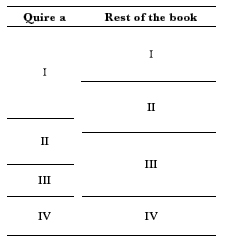| JAMES SHIRLEY'S TRIUMPH OF PEACE:
ANALYZING GREG'S NIGHTMARE
by
STEPHEN TABOR
| ||
§11. Phase I
Appendix 3 shows that eighteen of the nineteen copies surviving from Phase
I
(about 95%) are homogeneous throughout (ignoring stop-press corrections).
In other
words, they contain the earliest settings or impositions of all the
sheets
including the preliminaries. The one exception is Huntington 69434, in
which
quire D comes from the next printing. This is an example of the situation
just
described in which one quire was evidently printed a bit short in one phase
and
had to be completed from the next. There is nothing special about quire D
that
might have led to a short printing; recall from our type analysis that it was
prob-
ably printed third of the five quires in Phase I.
If quire D was printed short, it seems that quire "a" was printed long.
In
addition to the nineteen complete copies from Phase I, four copies from
the
second printing have Phase I preliminaries. This extrapolates to a 21%
surplus
of first-printing quire "a"—an odd amount, being too little to represent
an in-
tended second impression but too large to have resulted from a trifling
accidental
overrun. The discrepancy persists in Phase II, in which each quire
survives in
approximately equal numbers, but a residue of preliminaries is pushed
over into
Phase III copies. In Phase III, Norton apparently shorted the run of
quire "a"
by a number about equal to the initial overrun, so Phase IV copies are
finally
homogeneous (if we disregard Okes' contribution)–all "third impression"
title
pages come with text sheets from the last printing. The phase relationship
of
quire "a" with the main text looks like this:
 |

The first two impressions of the preliminaries may occur with either of
two
impressions of quires A-D, and the second and third printings of the main
text
can each come with two possible variants of the title page. It was this
ladder-like
asynchrony that led earlier bibliographers to believe that Norton had
printed
simultaneous duplicate settings of the text.
In a given copy, we should not necessarily expect early stop-press variants
of
any one sheet to sort with early states of the others, or later with later,
though
there may be a tendency for this to happen.
37
Appendix 3 indeed shows an es-
sentially random
pattern in this regard.
| JAMES SHIRLEY'S TRIUMPH OF PEACE:
ANALYZING GREG'S NIGHTMARE
by
STEPHEN TABOR
| ||